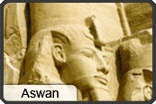 |
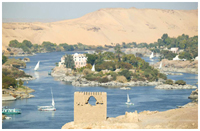 |
 |
Aswan, Egypt's sunniest southern city and ancient frontier town, has a distinctively African atmosphere. Small enough to walk' around and graced with the most beautiful setting on the Nile, the pace of life is slow and relaxing.Days can be spent strolling up and down the broad Corniche watching the sailboats etch the sky with their tall masts or sitting in floating restaurants listening to Nubian music and eating freshly-caught fish. |
| Here the Nile is at its most beautiful, flowing through amber desert and granite rocks, round emerald islands covered in palm groves and tropical plants. Explore the souk, full of the scent and color of spices, perfumes, scarves and baskets; view the spectacular sunsets while having tea on the terrace of the Old Cataract Hotel. Aswan has been a favorite winter resort since the beginning of the nineteenth century and it's still a perfect place to get away from it all. |
|
|
 |
|
 |
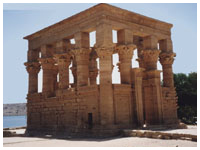 |
 |
Elephantine Island: |
One of the strongest forts along Egypt's southern borders, this island lies opposite to the "Cataract Hotel". Its chief deity was "Khnum", in the shape of a ram's head. The tourist is advised to first tour the island before visiting its monuments and museum.
|
| |
|
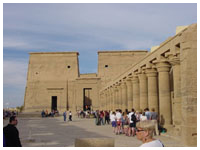 |
The Island Temples:
There are ruins of several stone temples from various periods. The inscriptions on the pylon of a hall in the southern temple depict Alexander II as king of Egypt while offering sacrifices to the local deities.
The Museum:
Located east of the old city, the museum houses a number of important relics from Greco-Roman times, collected from Aswan and Nubia. |
| |
Top |
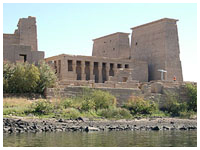 |
The Nilometre:
Dating to the Roman period, the Nilometre shows the height of the Nile floods in Greek, Demotic and Arabic, and was used until very recently.
The Gilika Island:
This Island now houses the Temple and relics of Philae Island that was submerged by the waters of the High Dam. The Temple of Philae was dismantled and re-assembled on this island which lies about 500 meters from the original Philae Island. Sound and Light Spectacle is performed in various languages.
|
| |
|
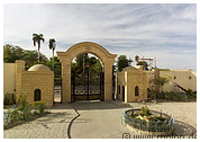 |
Plantation Island “Botanical Garden”:
Lies mid-stream, near Elephantine Island, is a natural exhibition of equatorial and tropical trees and shrubs.
Tombs of the Nobles:
These rock-tombs are hewn in the western hills, opposite the northern tip of Aswan, and date back to the 23rd century B.C. The inscriptions covering the walls of these tombs depict the role of these nobles in protecting the land, and of their journeys to the interior of Africa |
 |
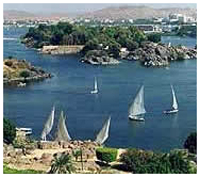 |
|
The Agha Khan Mausoleum: |
| The Mausoleum of the late leader of the Ismaili sect stands on the west bank opposite them Cataract Hotel. It is an exquisite example of Fatimid architecture. |
| |
|
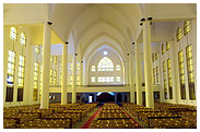 |
The Monastery of St Simeon
(Deir Amba Sama'an):
Dating back to the 6th century AD, the Monastery is one of the most intact Coptic monasteries, it comprises a church with paintings showing Christ and the Saints.
|
|
Top |
From Nubia Temples:
The Temple of Kalabsha:
Dating back to the Roman Emperor Octavius Augustus (30 BC-14 AD), the temple was moved from its original site 55 kms south of Aswan, on the west bank, and rebuilt near the High Dam. It is one of the largest sandstone temples in Nubia. Its walls are covered with texts and inscriptions depicting Egyptian deities such as Isis, Osiris and others.
Beit El Waly Temple:
This rock-hewn temple is one of the five temples built by Ramses II in Nubia. It comprises a courtyard, a hypostyle hail, and a kiosk, with multicolored texts and inscriptions, as well as scenes of the King in the battlefield. |
|
| |
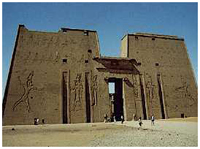 |
|
The Temple of Kom-Ombo: |
| Located in the town of Kom-Ombo, 45 kms north of Aswan, the Temple, dating to the Ptolemies, is built on a high dune overlooking the Nile. There are also tombs from the Old Kingdom in the vicinity of Kom-Ombo village. |
| |
|
 |
The Temple of Edfu : |
This huge and exquisite Temple, from the Ptolemic period, and devoted to the god, Horus, is located at the town of Edfu, 123 kms north of Aswan |
| |
Top |
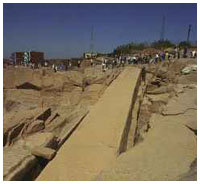 |
The Unfinished Obelisk: |
| This huge unfinished obelisk measures 41 meters in length and 4 meters square at the base. It is important because it shows the techniques adopted by the Ancient Egyptians in cutting out these obelisks. |
 |
 |
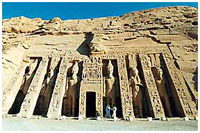 |
|
Abu Simbel This area is unacciessible except by boats, its well known for being a virgin area and has a lot of big fish ( sharks, groopers, mantarese and dolphins ).
We visit a lot of spectacular dive spots like (Elphinstone Reef, Abou Dabab and Dolphin Reef:).
The first, and largest of the temples, is dedicated to the sun god Ra-Harakhte, while the second, which is smaller, and a few meters to the north, was dedicated by Ramses II to his beautiful wife, Nefertari, to be worshipped together with other deities.
These two temples attracted world-wide attention when they were threatened by inundation by the waters of the High Dam. In response to an appeal by the Arab Republic of Egypt, UNESCO, in 1959, initiated an international donations campaign to save the monuments of Nubia, the relics of the oldest human civilization. The salvage of the Abu Simbel temples began in 1963, and cost some 36 million dollars. Once again the Abu Simbel temples were relocated on the plateau to greet the sunrise every morning.
|
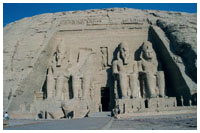 |
|
|
The Greater Abu Simbel Temple (Ramses II)
This is one of the many relics erected by the Pharaoh Ramses II, this is the grandest and most beautiful of temples. The facade is 33 meters high, and 38 meters broad, and guarded by for statues of Ramses II, each of which is 20 meters high. High on the facade, there is a carved row of baboons, smiling at the sunrise. On the doorway of the temple, there is a beautiful inscription of the king's name: Ser-Ma'at-Ra and between the legs of the colossal statues on the facade, we can see smaller statues of Ramses II's family: his mother "Mut-tuy", his wife "Nefertari" and his sons and daughters. There is also a number of dedications, important amongst which is Ramses II's marriage to the daughter of the King of the Hittites. Beyond their entrance, there is the Great Hall of Pillars, with eight pillars bearing the deified Ramses II in the shape of Osiris. The walls of this hall bear inscriptions recording the Battle of Kadesh waged by Ramses II against the Hittites. Then we enter the smaller hall of the temple - the hall of the nobles, containing four square pillars. Then we come to the Holiest of Holies, where we Amun-Ra find four statues of: Ra-Harakhte, Ptah, Amun-Ra and King Ramses II. This temple is unique, since the sun shines directly on the Holiest of Holies two days a year: February 21, the king's birthday, and October 22, the date of his coronation. |
|
Top |
The Smaller Abu Simbel Temple (Nefertari)
Located north of the Greater Temple, this was carved in the rock by Ramses II and dedicated to the goddess of Love and Beauty, Hathur, and also to his favorite wife, Nefertari. The Facade is adorned by six statues, four to Ramses II and two to his wife Nefertari. The entrance leads to a hall containing six pillars bearing the head of the goddess, Hathur. The eastern wall bears inscriptions depicting Ramses II striking the enemy before Ra-Harakhte and Amun-Ra. Other wall scenes show Ramses II and Nefertari offering sacrifices to the gods. Beyond this hall, there is another wall with similar scenes and paintings. Finally, we reach the Holiest of Holies, where we find the statue of the goddess Hathur.
This is, indeed, a most awesome sight to the visitor; for here he finds the greatest artificial dome that bears the man-made mountain behind the Temples of Abu Simbel. |
| |
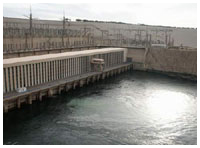 |
|
Features of Modern Aswan:
The Aswan Dam:
Built in 1902 AD south of Aswan, it signaled the beginning of modern irrigation in Egypt. |
| |
|
 |
The High Dam:
This 20th century engineering miracle is one of the largest dams in the world, and was built to safeguard Egypt against the high Nile floods, which either destroyed large tracts of land or ran wastefully into the Mediterranean. The dam, 111 meters above sea-level, is 3,600 meters long and 40 meters wide at the top. |
Top |
 |























